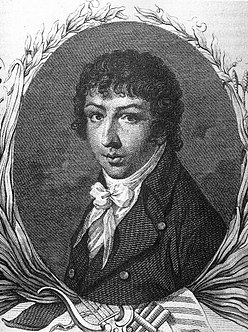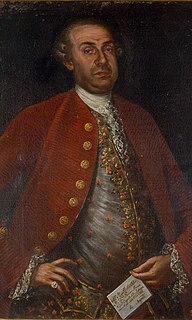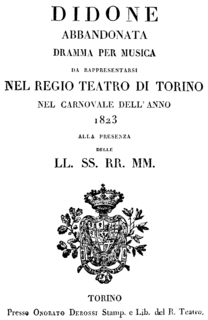
Pietro Antonio Domenico Trapassi, better known by his pseudonym of Pietro Metastasio, was an Italian poet and librettist, considered the most important writer of opera seria libretti.

Niccolò Jommelli was an Italian composer of the Neapolitan School. Along with other composers mainly in the Holy Roman Empire and France, he was responsible for certain operatic reforms including reducing ornateness of style and the primacy of star singers somewhat.
Theatres for diverse musical and dramatic presentations began to open in Naples, Italy, in the mid-16th century as part of the general Spanish cultural and political expansion into the kingdom of Naples, which had just become a vicerealm of Spain. None of the early theaters still function as such, having been replaced by later facilities from the mid-18th century onwards. Neapolitan theatres first built in the 16th and 17th centuries include:
Domenico Natale Sarro, also Sarri was an Italian composer.

Didone abbandonata is an opera libretto in three acts by Pietro Metastasio. It was his first original work and was set to music by Domenico Sarro in 1724. The opera was accompanied by the intermezzo L'impresario delle Isole Canarie, also by Metastasio.

Joseph Schuster was a German composer.

Giuseppe Maria Orlandini was an Italian baroque composer particularly known for his more than 40 operas and intermezzos. Highly regarded by music historians of his day like Francesco Saverio Quadrio, Jean-Benjamin de La Borde and Charles Burney, Orlandini, along with Vivaldi, is considered one of the major creators of the new style of opera that dominated the second decade of the 18th century.

Didone abbandonata was an opera in three acts composed by Tomaso Albinoni. Albinoni's music was set to Pietro Metastasio's libretto, Didone abbandonata, which was in turn based on the story of Dido and Aeneas from the fourth book of Virgil's Aeneid. The opera premiered on 26 December 1724 at the Teatro San Cassiano in Venice and was the first time that an opera based on a Metastasio libretto was performed in Venice.

Dido, Queen of Carthage was an opera in three acts by Stephen Storace. Its English libretto by Prince Hoare was adapted from Metastasio's 1724 libretto, Didone abbandonata, which had been set by many composers. Storace's opera premiered on 23 May 1792 at The King's Theatre in London combined with a performance of his masque, Neptune's Prophecy. The story is based on that of Dido and Aeneas in the fourth book of Virgil's Aeneid. The opera was not a success and was never revived after its original run of performances. The score has been lost.

Didone abbandonata is an opera in three acts composed by Domenico Sarro to a libretto by Pietro Metastasio of the same name which was based on the story of Dido and Aeneas from the fourth book of Virgil's Aeneid. The opera premiered on 1 February 1724 at the Teatro San Bartolomeo in Naples.

Annibale Pio Fabri, also known as Balino, from Annibalino, diminutive of his first name, was an Italian composer and singer of the 18th century. One of the leading tenors of his age in a time dominated by the castrati, Fabri is now best known for his association with the composer George Frideric Handel, in whose operas Fabri sang.
Pietro Chiarini was an Italian composer.
Ludger Rémy was a German harpsichordist, conductor and musicologist.

Gennaro Manna was an Italian composer based in Naples. He was a member of the Neapolitan School. His compositional output includes 13 operas and more than 150 sacred works, including several oratorios.
Axel Köhler is a German countertenor and opera director. In 1994, he won the Handel Prize. Since 2009, he has been Artistic Director of the Halle Opera House.
Antonio Boroni was an Italian composer.
Didone abbandonata is a setting by Leonardo Vinci of the libretto Didone abbandonata by Metastasio first set to music by Domenico Sarro in 1724. It was premiered at the Teatro delle Dame for the 1726 Carnival season in Rome.
Didone abbandonata is a 1742 opera by Johann Adolph Hasse setting the libretto Didone abbandonata by Metastasio. It was first performed at Hubertusburg palace, near Dresden.
Didone abbandonata is an opera in three acts by Niccolò Jommelli of the libretto Didone abbandonata by Pietro Metastasio. It was composed just after Jommelli left Venice in 1746 and revised in 1763. It was first performed on January 28, 1747 at the Teatro Argentina in Rome.

Didone abbandonata is an 1823 opera in two acts by Saverio Mercadante to a libretto by Andrea Leone Tottola after Metastasio's Didone abbandonata. It was first performed on 18 January 1823 at the Teatro Regio in Turin.














